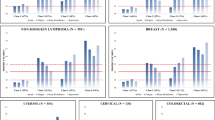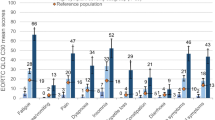Abstract
Purpose
Symptom clusters, the multiple, co-occurring symptoms experienced by cancer patients, are debilitating and affects quality of life. We assessed if a panel of immune-response genes may underlie the co-occurrence of severe pain, depressed mood, and fatigue and help identify patients with severe versus non-severe symptom clusters.
Methods
Symptoms were assessed at presentation, prior to cancer treatment in 599 newly diagnosed lung cancer patients. We applied cluster analyses to determine the patients with severe versus non-severe symptom clusters of pain, depressed mood, and fatigue.
Results
Two homogenous clusters were identified. One hundred sixteen patients (19 %) comprised the severe symptom cluster, reporting high intensity of pain, depressed mood, and fatigue and 183 (30 %) patients reported low intensity of these symptoms. Using Bayesian model averaging methodology, we found that of the 55 single nucleotide polymorphisms assessed, an additive effect of mutant alleles in endothelial nitric oxide synthase (-1474 T/A) (posterior probability of inclusion (PPI) = 0.78, odds ratio (OR) = 0.54, 95 % credible interval (CI) = (0.31, 0.93)); IL1B T-31C (PPI = 0.72, OR = 0.55, 95 % CI = (0.31, 0.97)); TNFR2 Met196Arg (PPI = 0.70, OR = 1.85, 95 % CI = (1.03, 3.36)); PTGS2 exon 10+837T > C (PPI = 0.69, OR = 0.54, 95 % CI = (0.28, 0.99)); and IL10RB Lys47Glu (PPI = 0.68; OR = 1.74; 95 % CI = (1.04, 2.92)) were predictive for symptom clusters.
Conclusions
Genetic polymorphisms may facilitate identification of high-risk patients and development of individualized symptom therapies.

Similar content being viewed by others
References
Reyes-Gibby CC, Wu X, Spitz M, Kurzrock R, Fisch M, Bruera E, Shete S (2008) Molecular epidemiology, cancer-related symptoms, and cytokines pathway. Lancet Oncol 9(8):777–785
Patrick DL, Ferketich SL, Frame PS, Harris JJ, Hendricks CB, Levin B, Link MP, Lustig C, McLaughlin J, Reid LD, Turrisi AT III, Unutzer J et al (2004) National Institutes of Health State-of-the-Science Conference Statement: symptom management in cancer: pain, depression, and fatigue, July 15–17, 2002. J Natl Cancer Inst Monogr 32:9–16
Kurzrock R (2001) The role of cytokines in cancer-related fatigue. Cancer 92(6 Suppl):1684–1688
Maier SF, Watkins LR (2003) Immune-to-central nervous system communication and its role in modulating pain and cognition: implications for cancer and cancer treatment. Brain Behav Immun 17(Suppl 1):S125–S131
Schubert C, Hong S, Natarajan L, Mills PJ, Dimsdale JE (2007) The association between fatigue and inflammatory marker levels in cancer patients: a quantitative review. Brain Behav Immun 21(4):413–427
Watkins LR, Maier SF (1999) Implications of immune-to-brain communication for sickness and pain. Proc Natl Acad Sci U S A 96(14):7710–7713
Anisman H, Ravindran AV, Griffiths J, Merali Z (1999) Endocrine and cytokine correlates of major depression and dysthymia with typical or atypical features. Mol Psychiatry 4(2):182–188
Musselman DL, Miller AH, Porter MR, Manatunga A, Gao F, Penna S, Pearce BD, Landry J, Glover S, McDaniel JS, Nemeroff CB (2001) Higher than normal plasma interleukin-6 concentrations in cancer patients with depression: preliminary findings. Am J Psychiatry 158(8):1252–1257
Rakvag TT, Ross JR, Sato H, Skorpen F, Kaasa S, Klepstad P (2008) Genetic variation in the catechol-O-methyltransferase (COMT) gene and morphine requirements in cancer patients with pain. Mol Pain 4:64
Rausch SM, Gonzalez BD, Clark MM, Patten C, Felten S, Liu H, Li Y, Sloan J, Yang P (2012) SNPs in PTGS2 and LTA predict pain and quality of life in long term lung cancer survivors. Lung Cancer 77(1):217–223
Reyes-Gibby CC, Shete S, Rakvag T, Bhat SV, Skorpen F, Bruera E, Kaasa S, Klepstad P (2007) Exploring joint effects of genes and the clinical efficacy of morphine for cancer pain: OPRM1 and COMT gene. Pain 130(1–2):25–30
Reyes-Gibby CC, Spitz M, Wu X, Merriman K, Etzel C, Bruera E, Kurzrock R, Shete S (2007) Cytokine genes and pain severity in lung cancer: exploring the influence of TNF-alpha-308 G/A IL6-174G/C and IL8-251T/A. Cancer Epidemiol Biomarkers Prev 16(12):2745–2751
Reyes-Gibby CC, El OB, Spitz MR, Parsons H, Kurzrock R, Wu X, Shete S, Bruera E (2008) The influence of tumor necrosis factor-alpha -308 G/A and IL-6–174 G/C on pain and analgesia response in lung cancer patients receiving supportive care. Cancer Epidemiol Biomarkers Prev 17(11):3262–3267
Reyes-Gibby CC, Shete S, Yennurajalingam S, Frazier M, Bruera E, Kurzrock R, Crane CH, Abbruzzese J, Evans D, Spitz MR (2009) Genetic and nongenetic covariates of pain severity in patients with adenocarcinoma of the pancreas: assessing the influence of cytokine genes. J Pain Symptom Manage 38(6):894–902
Reyes-Gibby CC, Spitz MR, Yennurajalingam S, Swartz M, Gu J, Wu X, Bruera E, Shete S (2009) Role of inflammation gene polymorphisms on pain severity in lung cancer patients. Cancer Epidemiol Biomarkers Prev 18(10):2636–2642
Swartz MD, Kimmel M, Mueller P, Amos CI (2006) Stochastic search gene suggestion: a Bayesian hierarchical model for gene mapping. Biometrics 62(2):495–503
Swartz MD, Yu RK, Shete S (2008) Finding factors influencing risk: comparing Bayesian stochastic search and standard variable selection methods applied to logistic regression models of cases and controls. Stat Med 27(29):6158–6174
Wei Q, Cheng L, Amos CI, Wang LE, Guo Z, Hong WK, Spitz MR (2000) Repair of tobacco carcinogen-induced DNA adducts and lung cancer risk: a molecular epidemiologic study. J Natl Cancer Inst 92(21):1764–1772
Caraceni A, Cherny N, Fainsinger R, Kaasa S, Poulain P, Radbruch L, De Conno F (2002) Pain measurement tools and methods in clinical research in palliative care: recommendations of an Expert Working Group of the European Association of Palliative Care. J Pain Symptom Manage 23(3):239–255
Vilaseca I, Chen AY, Backscheider AG (2006) Long-term quality of life after total laryngectomy. Head Neck 28(4):313–320
Ware J Jr, Kosinski M, Keller SD (1996) A 12-Item Short-Form Health Survey: construction of scales and preliminary tests of reliability and validity. Med Care 34(3):220–233
Engels EA, Wu X, Gu J, Dong Q, Liu J, Spitz MR (2007) Systematic evaluation of genetic variants in the inflammation pathway and risk of lung cancer. Cancer Res 67(13):6520–6527
National Comprehensive Cancer Network (2007) http://www.nccn.org/professionals/physician_gls/PDF/pain.pdf. 2010 Accessed 2007 Sept. 12
Barbieri MM, Berger JO (2004) Optimal predictive model selection. Ann Stat 32(3):870–897, 2010
Viallefont V, Raftery AE, Richardson S (2001) Variable selection and Bayesian model averaging in case-control studies. Stat Med 20(21):3215–3230
Chen H, Wilkins LM, Aziz N, Cannings C, Wyllie DH, Bingle C, Rogus J, Beck JD, Offenbacher S, Cork MJ, Rafie-Kolpin M, Hsieh CM et al (2006) Single nucleotide polymorphisms in the human interleukin-1B gene affect transcription according to haplotype context. Hum Mol Genet 15(4):519–529
El-Omar EM, Carrington M, Chow WH, McColl KE, Bream JH, Young HA, Herrera J, Lissowska J, Yuan CC, Rothman N, Lanyon G, Martin M et al (2000) Interleukin-1 polymorphisms associated with increased risk of gastric cancer. Nature 404(6776):398–402
Martucci C, Trovato AE, Costa B, Borsani E, Franchi S, Magnaghi V, Panerai AE, Rodella LF, Valsecchi AE, Sacerdote P, Colleoni M (2008) The purinergic antagonist PPADS reduces pain related behaviours and interleukin-1 beta, interleukin-6, iNOS and nNOS overproduction in central and peripheral nervous system after peripheral neuropathy in mice. Pain 137(1):81–95
Neeb L, Hellen P, Boehnke C, Hoffmann J, Schuh-Hofer S, Dirnagl U, Reuter U (2011) IL-1beta stimulates COX-2 dependent PGE synthesis and CGRP release in rat trigeminal ganglia cells. PLoS One 6(3):e17360
Baune BT, Dannlowski U, Domschke K, Janssen DG, Jordan MA, Ohrmann P, Bauer J, Biros E, Arolt V, Kugel H, Baxter AG, Suslow T (2010) The interleukin 1 beta (IL1B) gene is associated with failure to achieve remission and impaired emotion processing in major depression. Biol Psychiatry 67(6):543–549
Von Ah DM, Kang DH, Carpenter JS (2008) Predictors of cancer-related fatigue in women with breast cancer before, during, and after adjuvant therapy. Cancer Nurs 31(2):134–144
Ferreira SH, Lorenzetti BB, Bristow AF, Poole S (1988) Interleukin-1 beta as a potent hyperalgesic agent antagonized by a tripeptide analogue. Nature 334(6184):698–700
Maier SF, Wiertelak EP, Martin D, Watkins LR (1993) Interleukin-1 mediates the behavioral hyperalgesia produced by lithium chloride and endotoxin. Brain Res 623(2):321–324
Maes M, Bosmans E, Meltzer HY, Scharpe S, Suy E (1993) Interleukin-1 beta: a putative mediator of HPA axis hyperactivity in major depression? Am J Psychiatry 150(8):1189–1193
Reinertsen KV, Grenaker Alnaes GI, Landmark-Hoyvik H, Loge JH, Wist E, Kristensen VN, Fossa SD, Edvardsen H (2011) Fatigued breast cancer survivors and gene polymorphisms in the inflammatory pathway. Brain Behav Immun 25(7):1376–1383. doi:10.1016/j.bbi.2011.04.001
Gelinas C, Fillion L (2004) Factors related to persistent fatigue following completion of breast cancer treatment. Oncol Nurs Forum 31(2):269–278
Muller N, Riedel M, Schwarz MJ (2004) Psychotropic effects of COX-2 inhibitors—a possible new approach for the treatment of psychiatric disorders. Pharmacopsychiatry 37(6):266–269
Dolan S, Field LC, Nolan AM (2000) The role of nitric oxide and prostaglandin signaling pathways in spinal nociceptive processing in chronic inflammation. Pain 86(3):311–320
Nijs J, Van de Velde B, De Meirleir K (2005) Pain in patients with chronic fatigue syndrome: does nitric oxide trigger central sensitisation? Med Hypotheses 64(3):558–562
Thabet S, Ben NM, Zaafrane F, Gaha L, Ben SK, Romdhane A, Nour M, Jrad BB (2011) Association of the Met-196-Arg variation of human tumor necrosis factor receptor 2 (TNFR2) with paranoid schizophrenia. J Mol Neurosci 43(3):358–363
Jensen MP (2003) The validity and reliability of pain measures in adults with cancer. J Pain 4(1):2–21
Butt Z, Wagner LI, Beaumont JL, Paice JA, Peterman AH, Shevrin D, Von Roenn JH, Carro G, Straus JL, Muir JC, Cella D (2008) Use of a single-item screening tool to detect clinically significant fatigue, pain, distress, and anorexia in ambulatory cancer practice. J Pain Symptom Manage 35(1):20–30
Acknowledgments
CA109043, CA128069, CA127219, CA123109, and DE022891 from the National Institutes of Health and is supported in part by the NIH/NCI through MD Anderson’s Cancer Center Support grant CA016672.
Conflict of interest
All authors have no potential conflicts of interest.
Author information
Authors and Affiliations
Corresponding author
Rights and permissions
About this article
Cite this article
Reyes-Gibby, C.C., Swartz, M.D., Yu, X. et al. Symptom clusters of pain, depressed mood, and fatigue in lung cancer: assessing the role of cytokine genes. Support Care Cancer 21, 3117–3125 (2013). https://doi.org/10.1007/s00520-013-1885-5
Received:
Accepted:
Published:
Issue Date:
DOI: https://doi.org/10.1007/s00520-013-1885-5




